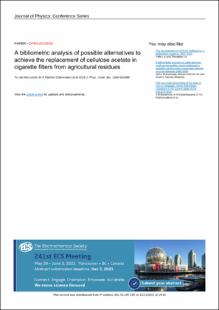A Bibliometric analysis of possible alternative to achieve the replacement of cellulose acetate in cigarette filters from agricultural residues
...
Orjuela Abril, Martha Sofia | 2019-11-29
Polymers have become one of the most recognized materials in the industry, due to their good physical properties and the efficiency of their production process, in addition to the versatility and breadth of their fields of application in the aerospace, automotive, construction, textile and adhesive industries. In the case of cellulose acetate, it is used in a wide variety of everyday products such as photographic films, varnishes and cigarette filters, which makes it a factor that negatively affects the environment, since this material takes a long time to decompose and in the process contaminates the place where it is located with particles, on the other side are the agricultural residues that are manipulated in an inappropriate way, generating contamination in landfills and water sources, the following bibliometric analysis was carried out in order to provide a solution to the worrisome situation of this polymer contamination and the agricultural residues contamination, in order to encourage the development of studies focused on producing degradable materials. Therefore, this article presents a bibliometric analysis on the various alternatives to replace cellulose acetate, focusing on the collection methodology and comparison of studies with a tool known as HitsCite. The articles have been investigated by bibliometric, trend and cluster analysis in a sample of 361 articles. The research has been carried out in one of the most recognized databases such as web of science and has allowed to identify the main trends and dynamics of the scientific literature. This in order to mitigate the environmental problems that are present in our environment and being a starting point to support monetary studies that implement environmentally friendly materials, being a topic that can create a positive and innovating impact in the industries commercial sectors.
LEER










